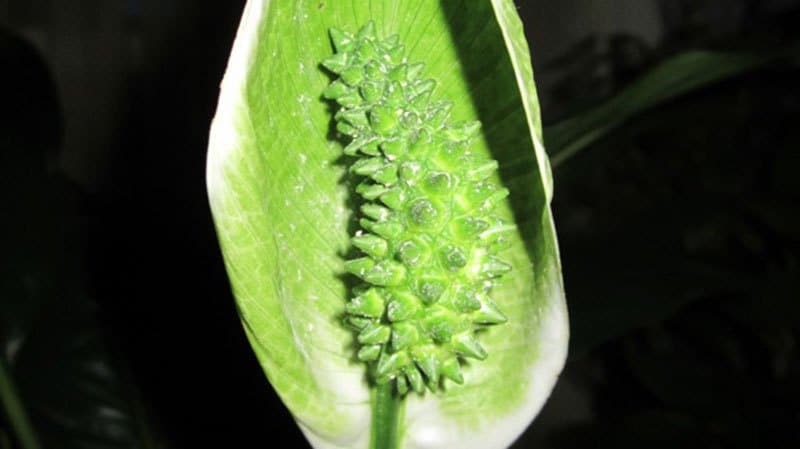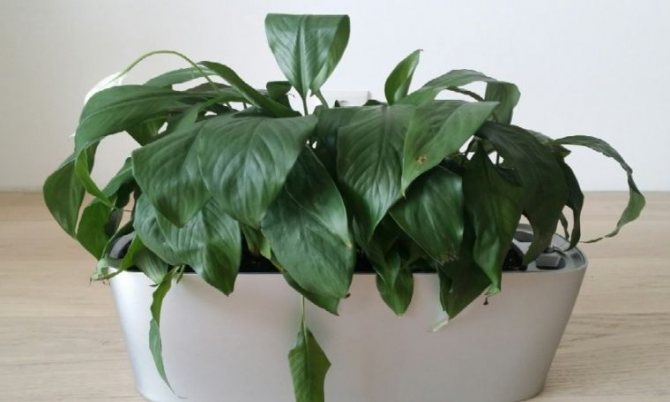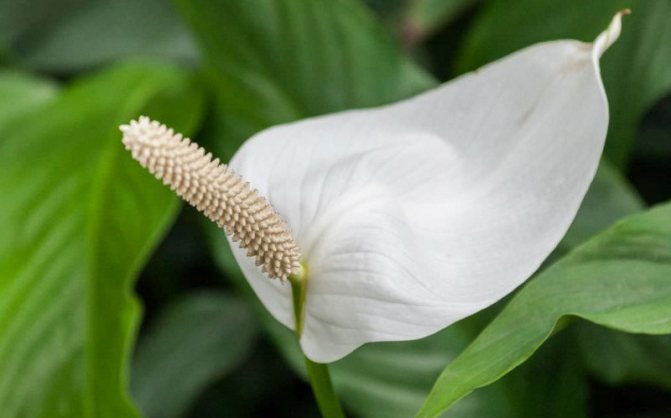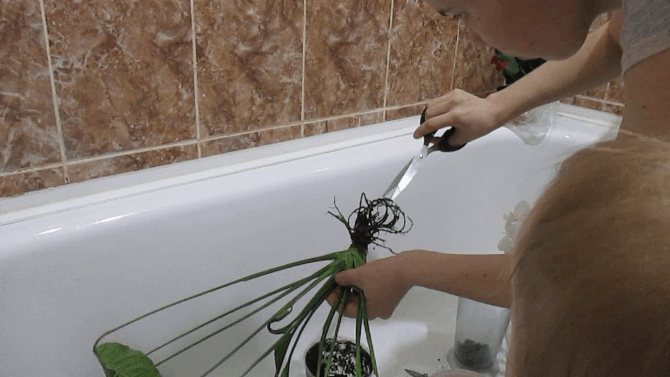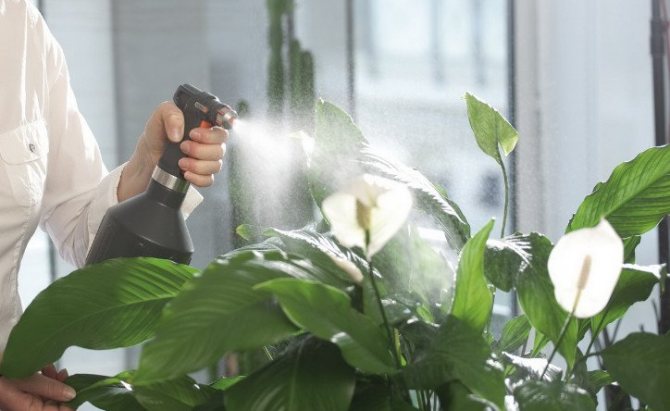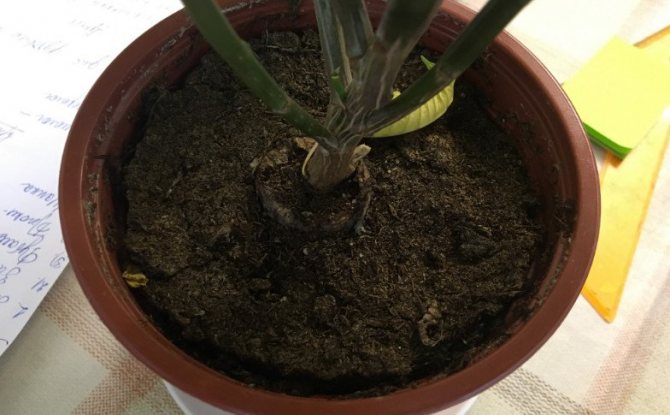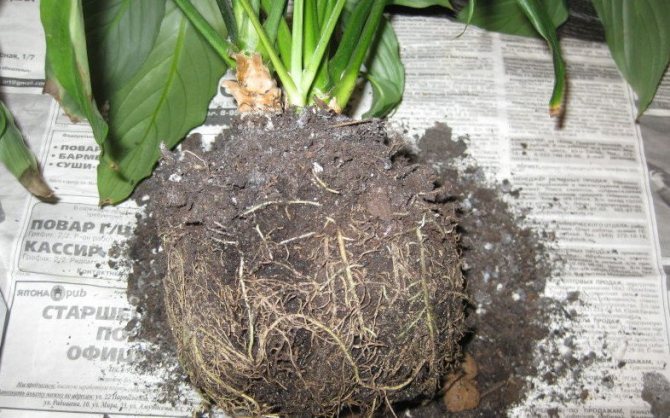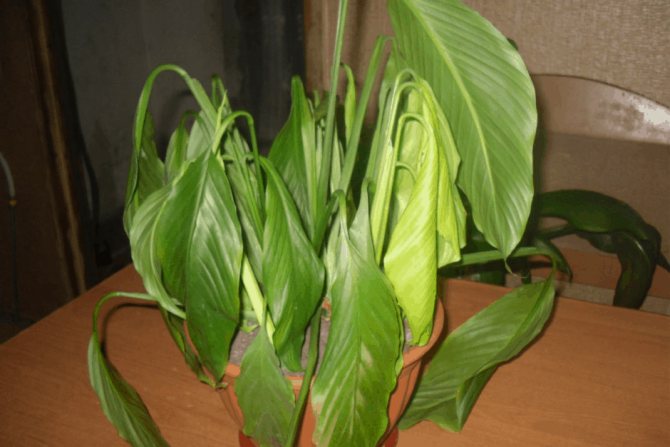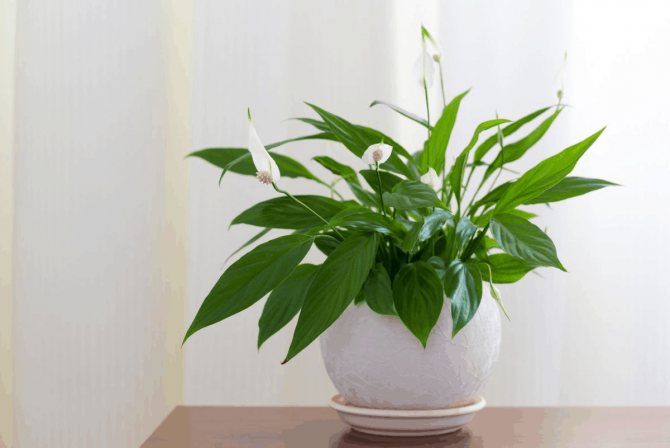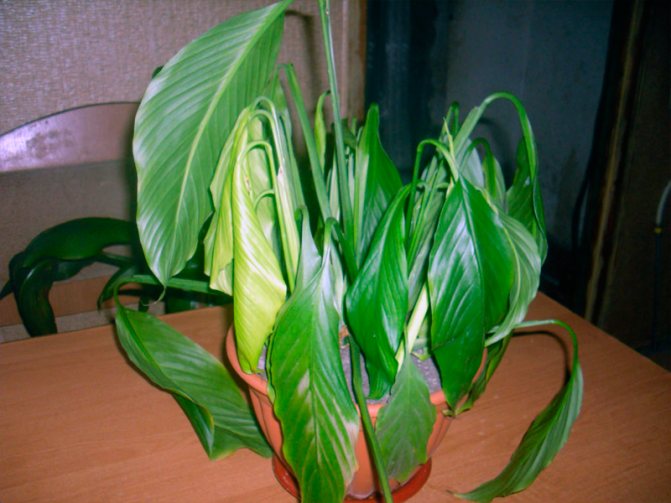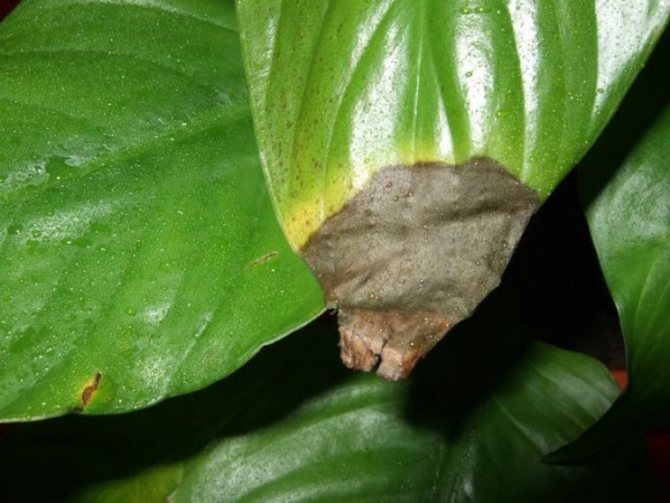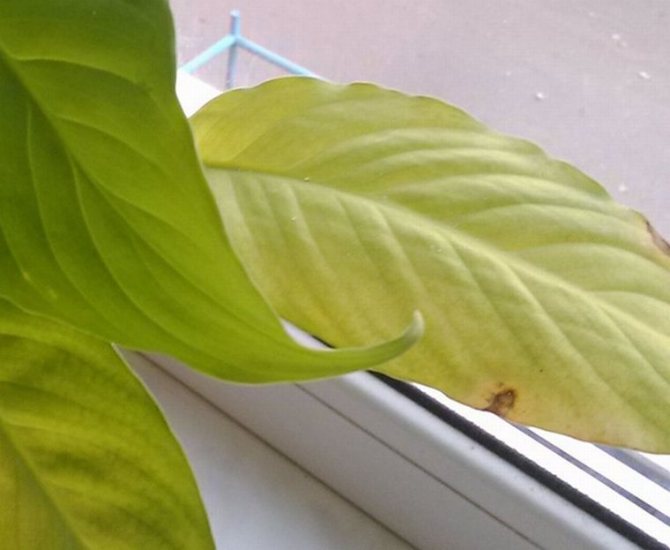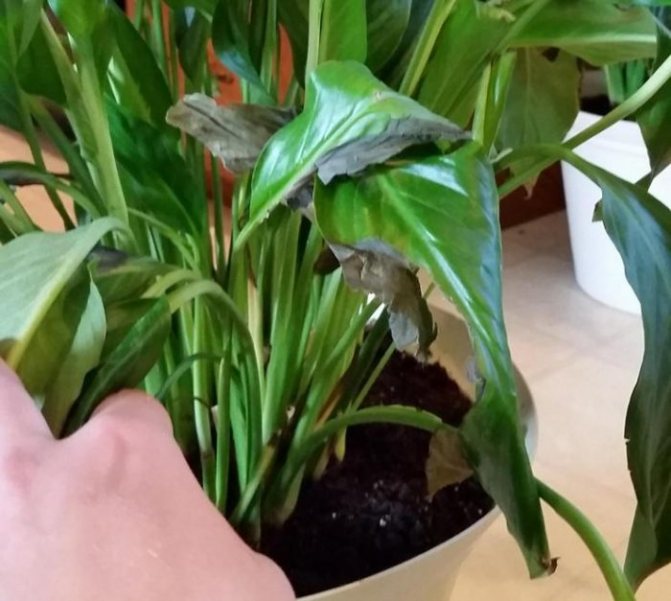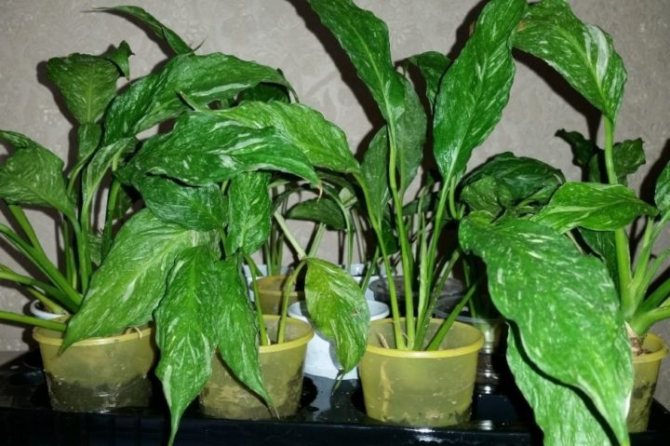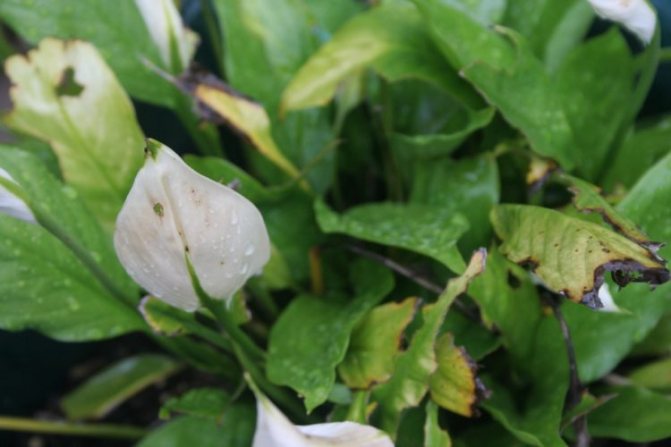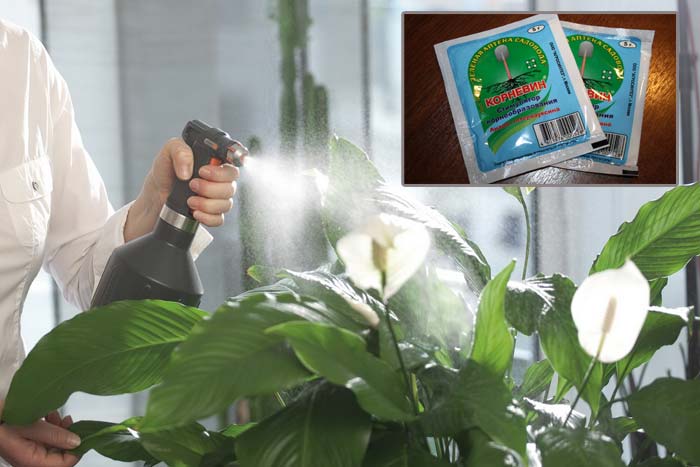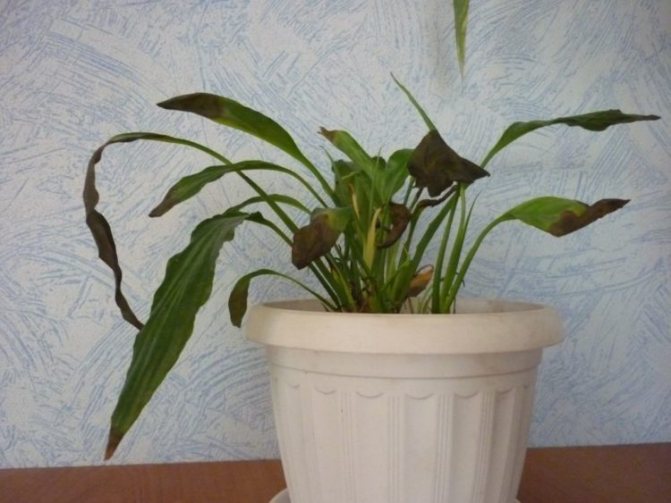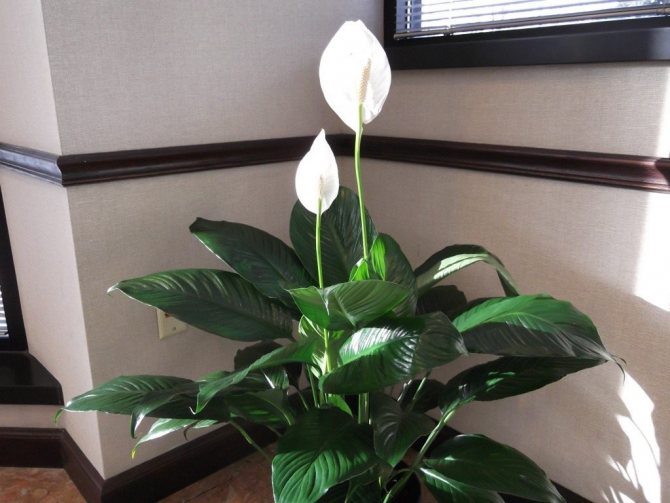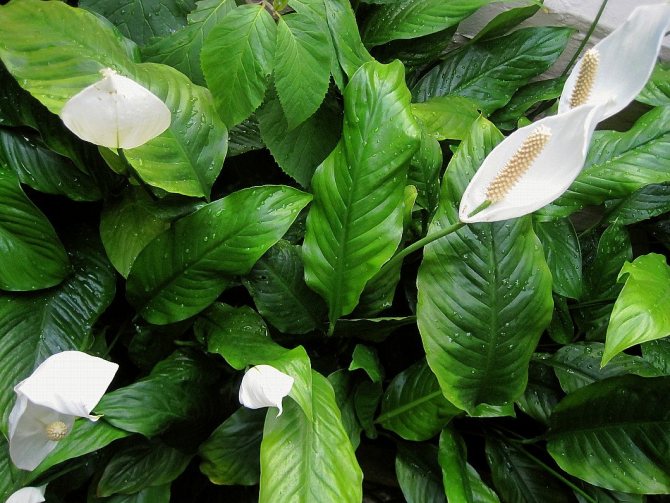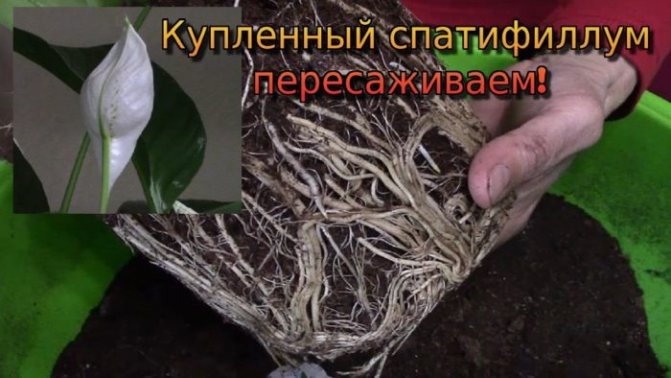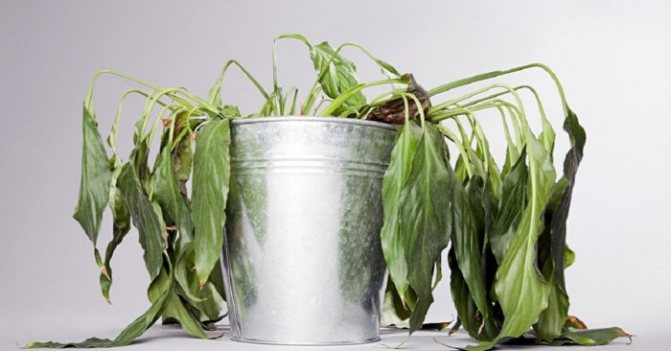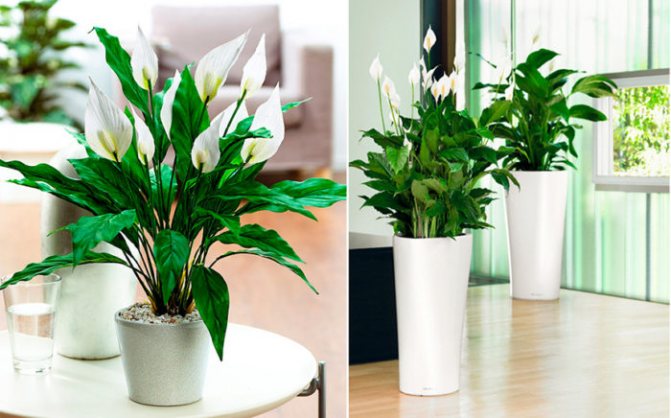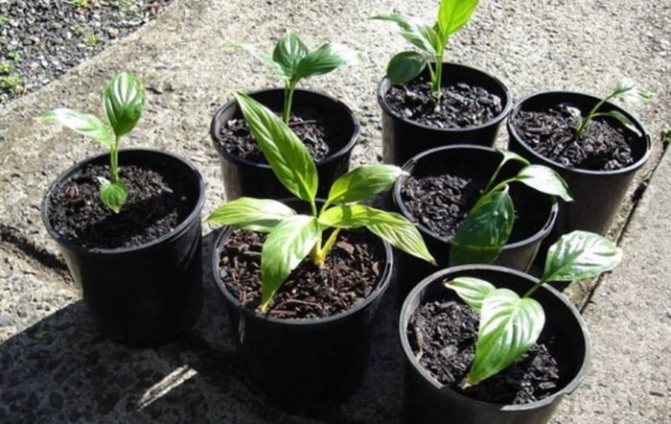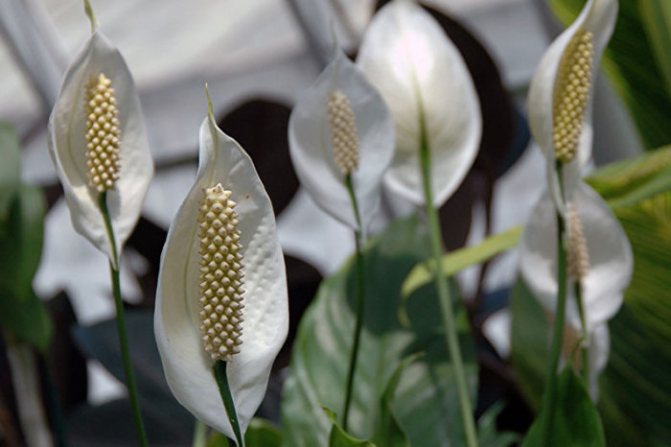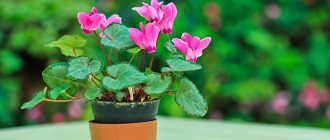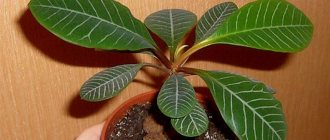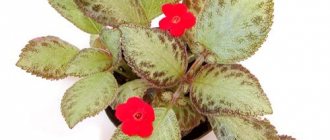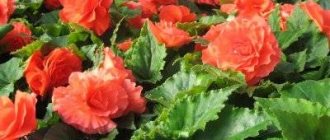Spathiphyllum is traditionally considered a female flower that brings good luck in personal life - therefore it is often called “female happiness”. It is not surprising that at least one pot of this plant can be found in almost every apartment. I have it too, of course.
I took my copy from friends when their flower grew too much and it was time to resettle it. It was only after the transplant that he suddenly began to fade. Although it is a very resistant plant, there are several reasons why Spathiphyllum drops its leaves, and in this article I want to share my experience of what to do when doing this.
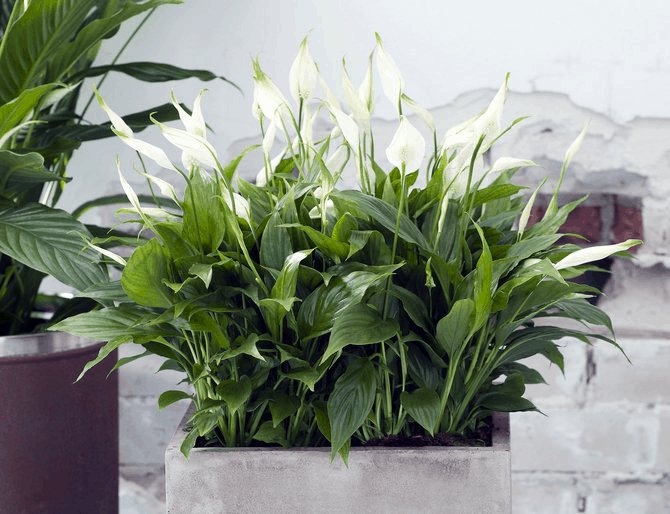
Temperature
The optimum temperature should be somewhere around 22 degrees, otherwise your pet, spathiphyllum, is withering away. In winter, it is better to remove the flower from the cold windowsill and put it in another place. The plant is afraid of drafts, and you need to carefully monitor the plant, and if you notice that the leaves suddenly become soft and somehow lethargic, then you know it is cold. Your flower will also feel very great next to the window, but only in the place where there is a slight partial shade. If there is no space near the window, then a window sill from either side may come up, but it is not recommended to choose the south side.
What is the benefit to humans?
Spathiphyllum is able to cleanse the air of harmful substances that are absorbed by its leaves, then these substances pass to the roots through the entire plant, and the microorganisms in the soil break down unnecessary components. Spathiphyllum also perfectly decorates a room, and with proper care it will delight its owners with its beauty for a long time.


The answer to the question whether spathiphyllum is harmful to human health can only be positive. The flower is especially dangerous for people with weak immunity and children. If you accidentally eat any of the parts of this plant, inflammation of the mucous membrane of the mouth and esophagus, severe cutting pains in the abdomen and upset stomach can occur (you can find out about what the organs of spathiphyllum are, as well as see a photo here).
Also this seemingly harmless plant can cause inflammation of the airwayswhich leads to shortness of breath. People who are prone to allergies develop skin rashes or other allergic reactions.
For the home, spathiphyllum does not pose any danger, but on the contrary, it helps to purify the air, remove carbon dioxide from it and oxygenate it.
The plant contains poisonous juice, and if your pet, be it a cat or a dog, eats this flower, then it will begin to swell and swell in the mouth, larynx and respiratory tract. If the sap of the plant gets into the eyes of the animal, inflammation of the corneal tissues can begin, which can no longer be stopped.
Why do spathiphyllum leaves turn black
One of the most popular and spectacular representatives of indoor flora is the tropical guest spathiphyllum. This wonderful plant is better known under a different name - "female happiness". Lush green bushes, although they bloom in monochrome snow-white colors, attract attention with an interesting structure of inflorescences. Varietal diversity is highly valued, including cultivars of various heights and foliage colors.Women's happiness is often presented as a gift, as a symbol of harmony in relationships and a talisman for finding a good spouse. It often happens that spathiphyllum falls into the hands of an inexperienced grower who has no idea how to properly care for it. Violation of the rules of cultivation leads to a loss of decorativeness, which is why the leaves of spathiphyllum turn black, turn yellow or wither. How to return beauty to a green pet, you will learn from the materials of the article.
Prevention
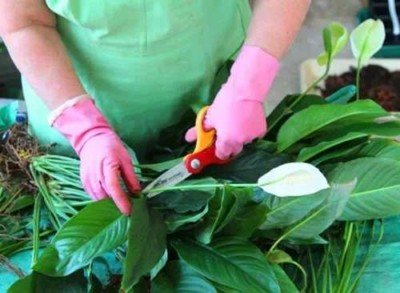

During the flowering period, you need to be especially careful with this plant, especially when caring for it.
If you cut the plant, then it is better to do it with glovesso that the caustic juice does not get on the skin and cause irritation.
- Be sure to wash your hands after handling the flower.
- If spathiphyllum juice does get on your skin, rinse it with cold water.
- If the juice gets into the eyes, you need to do the same, but if the tissues are severely inflamed, consult a doctor immediately.
- If any part of the plant accidentally gets into your mouth, rinse it thoroughly with water and never swallow this water.
When spathiphyllum blooms, it is better to limit contact with it as much as possible and take it to another room, put it away from children.
Everyone wants to decorate their home with beautiful indoor plants, but some of them can be poisonous, so before purchasing your favorite copy, carefully read its featuresso that instead of good, the plant will harm you.
Beauty requires sacrifice, but if the harm from a plant is too great, it is better to refuse to grow it at home and choose a more harmless flower.
If you find an error, please select a piece of text and press Ctrl + Enter.
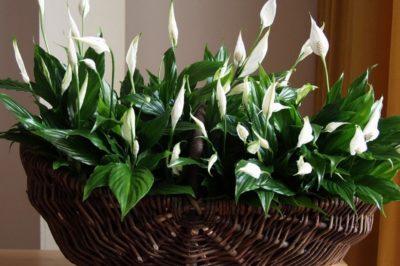

Spathiphyllum ("Women's happiness") is an unpretentious plant that is grown not only to decorate the house, but also to purify the air in the room. Its leaves absorb harmful particles through the production of biological substances.
But with spathiphyllum, you need to be careful, as if mishandled, it can cause allergies and poisoning. Today you will find out how this flower is useful and harmful. We also recommend watching a useful video on this topic.
Spathiphyllum - description, photo
The genus Spatiphillum united about 50 plant species common in tropical rainforests. Most of the representatives of the genus are terrestrial, grow on soft forest litter, rich in organic matter. Some inhabitants strive to receive more sunlight, therefore, they use tree branches as a support, that is, they are epiphytes.
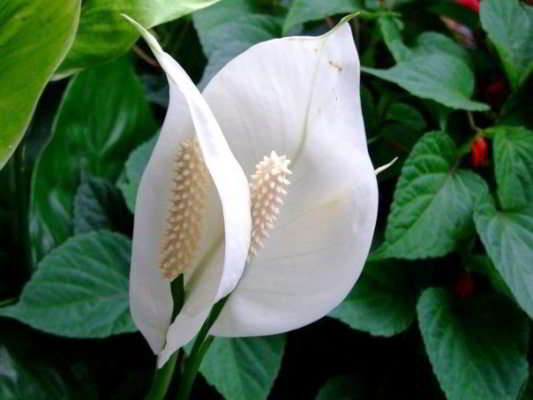

The advantages of such a lifestyle are inaccessibility for herbivores and independence from forest litter. Lush bushes are often found near water bodies, they like wetlands. Spathiphyllum has no definite homeland, since various species can be found not only in the tropical zone of South and Central America, but also in New Guinea, located near Australia.
Evergreen representatives of the genus are included in the Aroid family. The genus name is formed from two Latin words, which literally translate as “leaf” and “veil”. If you look at the plant, you can immediately guess that we are talking about a flower cob wrapped in a snow-white blanket. Often, the white bracts are compared to a flag, therefore spathiphyllum is sometimes called a flagolist.
The plant forms neat, fast-growing bushes that produce a large number of daughter rosettes. The exotic plant does not have a central stem, so the petioles are attached to the shortened rhizome and are shown directly from the soil.
Leaf blades with a solid edge differ in color, size, shape, depending on the species and variety.The leaves can be ovoid, oval, elongated-lanceolate, but the central vein on them is pronounced. The lower part of the petiole is provided with a stalk-enveloping extension with a powerful vascular network.
Peduncles are equal in height to leaf petioles or slightly exceed them. The type of inflorescence is the ear, which is attached to the peduncle or short stalk. The inflorescence consists of tiny male and female flowers, located very tightly to each other. There is a white or greenish blanket around the ear.
The bract acts as a petal to attract potential pollinators. As the flag withers, the flag loses its snow-white color and turns green, merging with the deciduous mass. Small smooth seeds are formed inside the ear, which very quickly lose their germination. The main breeding method at home is by dividing the bush or separating daughter outlets.
The discovery of exotic belongs to the German botanist H. Wallis, after whom the most widespread species in culture is named. Only a few decades after the discovery, breeders became interested in this unusual flower. Feminine happiness attracts flower growers with a long flowering period, during which a delicate pleasant aroma spreads.
On the basis of spathiphyllum, discovered by Gustav Wallis, a lot of varieties have been bred, which differ in the height and dimensions of the bushes, the size, shape, and color of the leaf plates. Particularly highly valued are tiny varieties (Mini, Kroshka), reaching only 10-15 cm in height and real giants (Sensation, Pablo, Silvio suite) growing up to one and a half meters with spectacular large foliage. The interior of any room will be decorated with variegated hybrids (Picasso, Caiti, Domino), and there are also varieties bred specifically for cutting (Mauna Loa). In addition, the culture is very unpretentious, shade-tolerant.
Consider the main varieties that can be found in culture:
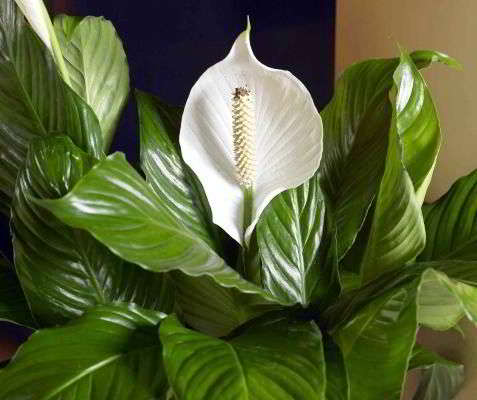

Flower allergy female happiness
Usually, spathiphyllum can only cause allergies during flowering, because it is flowers that cause allergies, since they have a very strong smell. In both a child and an adult, allergy symptoms manifest themselves in the same way:
- fear of light;
- sweating;
- convulsions;
- labored breathing;
- weakness;
- skin rashes.
Treatment is prescribed by the doctor after the patient has passed all the tests. Usually, the following drugs are prescribed for treatment:
- Anti-inflammatory drugs such as:
For the prevention of allergies, it is recommended to take these drugs a month before flowering and throughout the flowering period.
- Topical steroids are prescribed if other medications do not work. The dosage for children should be no more than half of the dosage for adults.
- Antagonists of H1-histamine receptors... Antagonists of 2-3 generations are suitable for the treatment of children, since they do not cause side effects. You can use drugs such as:
Why did spathiphyllum turn black
The most common problem faced by a novice grower is the appearance of blackness on the deciduous mass. It can arise from various external factors, but the reason always lies in the violation of the rules for caring for a flower. By the location of the blackness, it is often possible to determine the cause of the disease state of the plant.
Leaves around the edges
The appearance of significant darkening zones along the edge of the leaf blade of the spathiphyllum indicates excessive moisture. Despite the love for moisture, an excessive amount of life-giving liquid will certainly destroy the green bush.
The constant stay of roots in the "swamp" is unacceptable! Watering women's happiness is necessary after the top layer of soil in a pot dries up. It is also impossible to wait for the soil to dry out, because it will lead to the death of the flower.
Irrigation will have a beneficial effect on the health of the green ward only in moderation. In the summer, the crop should be watered frequently and abundantly. It is better to use the bottom irrigation method so that the earthen clod absorbs the required amount of liquid. After 2 hours, drain the excess liquid from the pan. The winter irrigation regime is more moderate, because the combination of dampness and coolness is the optimal condition for the development of fungi.
When dark spots are located along the edge of the leaves, the root system has already begun to rot, without your help the home exotic will die. An emergency transplant and "surgical" intervention is required.
And also water always stagnates in an incorrectly selected substrate. In a humid tropical forest, the exotic lives on a litter consisting of decayed parts of plants. Purchase the substrate from a specialty store or make your own by mixing leafy soil with turf and peat. Take the components in equal proportions. Season the finished soil mixture with charcoal and perlite or coarse sand. Such soil will easily allow moisture and air to pass through, without turning the pot into a swamp.
Leaves at the tips
If blackness appears at the very tip of the leaf, and the rest of the plate looks healthy, the reason lies in insufficient air humidity. At home, the exotic lives in the humid atmosphere of the tropical forest.
At home, such conditions can be recreated using simple techniques - spraying, installing in a tray with wet pebbles or moss, placing the pot near the aquarium. But in winter, due to the included batteries, the problem is exacerbated. Indoor moisture evaporates very quickly. If standard measures are not enough, a humidifier is used. Bathing in the shower will have a beneficial effect on the condition of the crown.
Leaves in the middle
The appearance of dark brown-brown or black spots in the middle of the leaf blade may be the result of root decay. The reason lies in the improperly organized irrigation regime. If the substrate is normal, you may have exposed the crown of the spathiphyllum to direct sunlight. Burns appear in a similar way, and then the leaves begin to turn yellow and die off.
The flower grows in the forest, under the shade of trees, so it loves diffused light, try to protect it from the scorching rays on the southern windowsill with tulle. Women's happiness will feel more comfortable on the east or west window.
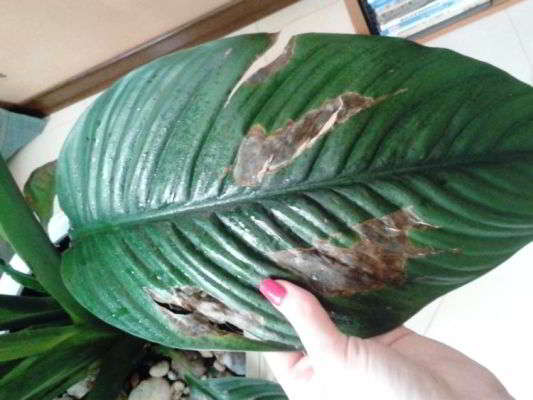

Black spots in the middle of the leaves sometimes indicate hypothermia of the root system. Remember that an exotic guest cannot stand a draft and likes to keep his feet warm. If there is a draft on the windowsill, place a foam circle under the pot. The normal temperature for an exotic guest is 23-25⁰C, in winter not lower than 15⁰C. Nighttime temperature fluctuations will lead to cooling of the moist substrate, making the delicate roots freeze.
Leaf tips
If the tip of the leaf turns black, but a larger area is affected than in the first case, the root system suffers from a chemical burn. Surely the other day you introduced the next portion of top dressing and did not comply with the correct dosage or violated the fertilization schedule. In this case, it is impossible to hesitate, urgently transplant "female happiness" into fresh soil, carefully washing the roots.
Remember that fertilizer should be applied in spring and summer twice a month. It is optimal to choose a liquid composition designed specifically for Aroids. If using conventional liquid fertilizer for flowering houseplants, the dosage should be halved.
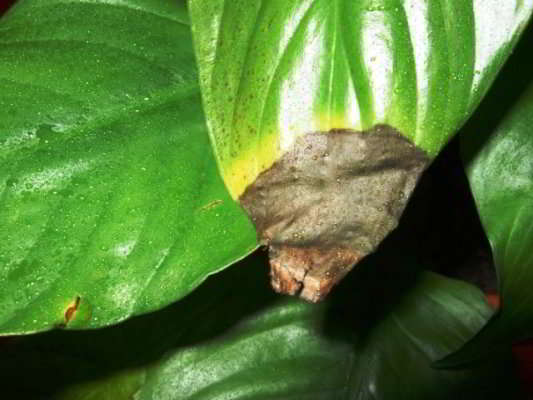

In winter, top dressing is contraindicated, since they provoke growth, which is why the bush stretches out, loses its decorative effect. If kept year-round under artificial light, feed the flower with minerals twice a month.
Poisonous plant or not?
It is believed that spathiphyllum is able to trap harmful components in the air and neutralize them... The leaves absorb them and pass them through the entire body to the roots. And all the microbes that live in the soil break down pathogenic microorganisms in the root system.
Science also confirms this statement, but in practice, sometimes different results are achieved. The plant is poisonous, so small children and animals should be kept away when growing. Otherwise, with proper care, spathiphyllum "will behave normally" and will not harm either the house or its inhabitants.
You can find out if spathiphyllum is poisonous for a cat here.
Why do the leaves and flowers turn black, what should I do?
If blackness appeared not only on the deciduous mass, but also affected the delicate flags, the health of your pet is at risk! This reaction of the flagleaf is characteristic when the substrate is excessively wet, which led to rotting of the roots.
What can you do to save Spathiphyllum? When the roots rot, only one option is possible - an emergency transplant. It is performed as follows:
- Remove the diseased specimen from the pot.
- Place the root system in a bucket of water, gently loosen the roots from the earthy ball.
- Perform a thorough examination, remove all rotten parts (yellow or brown, soft to the touch) with a sterile knife to healthy tissue.
- Soak the root lobe in a fungicide solution or light pink potassium permanganate solution.
- Treat the wounds with crushed coal, dry the roots for 2 hours.
- Place drainage on the bottom of a new pot, add some fresh soil. Place the spathiphyllum in the prepared container, fill in the gaps.
- The finished soil mixture contains a small amount of moisture, so additional watering is not required. If the soil is dry, water it a little.
- When the time comes for the next irrigation, pour the flower with warm, settled water with the addition of Kornevin. Spray the transplanted specimen daily.
Allergy to the flower "Women's happiness"
What exactly is causing it?
Spathiphyllum causes allergies in a child and an adult during the flowering process... Moreover, at a time when it is absent, adults and children do not feel any discomfort and allergy symptoms.
Symptoms in children and adults
If there is an allergy to spathiphyllum, then it can be recognized in children and adults by the following signs:


fear of light;- shortness of breath, unproductive cough;
- skin rash;
- migraine;
- headaches;
- general weakness;
- seizures;
- sweating
During an allergy to the bloom of spathiphyllum, symptoms of bronchial asthma may occur. - attacks of suffocation, dry cough and wheezing. Pollen dermatitis and urticaria are rare. At the same time, the temperature indicators of the body remain normal.
The duration of a seasonal allergy to a flower does not exceed 2 months, but lowering a person's contact with an allergen and using preventive measures, all symptoms will go away faster and less pronounced.
Treatment
The doctor will be able to draw up a treatment regimen only after passing all the tests. Drug therapy includes the following drugs:
- Anti-inflammatory drugs: Lomuzol, Kromoglin, Lekrolin, Kromosol, Allergokrom. It is advisable to use them a month before flowering and take until the end of this period.
- Topical steroids... These drugs are prescribed only if there is no effect from the use of previous drugs. For children, the dosage will be ½ of adults.
- Antagonists of H1-histamine receptors... They are prescribed for allergic rhinitis. For the treatment of a child, antihistamines of the 2-3rd generation are used, since they do not have side symptoms. Such drugs are effective: Loratadin (Claritin), Ebastin (Kestin), Desloratadin (Erius) Cetirizine (Zyrtec), or Fexofenadine (Telfast). They are taken orally once a day.
Possible causes of leaf blackening
So, blackening of the leaves of spathiphyllum may be due to the following reasons:
- the roots are frozen;
- excessive soil moisture;
- insufficient air humidity;
- overfeeding with fertilizers;
- sunburn;
- the substrate is incorrectly selected.
It will not be easy to restore a decorative look to women's happiness, and in some cases it will even be necessary to fight for its life. That is why it is better to study the rules of plant care right away than to eliminate the consequences of your own mistakes!
Useful properties of statiphyllum
One of the reasons why flower growers love spithimufillum so much is the ability of this indoor plant to purify the air. This indoor flower does an excellent job of neutralizing harmful substances present in the air, for example, acetone, carbon monoxide, formaldehyde, xylene, benzene, etc. It is enough just to leave the pot with the "white sail" for several hours in a room where the air is polluted with harmful substances, and you can forget about this problem.
In addition, there is an opinion that this houseplant is capable of mysteriously solving many life problems or, on the contrary, creating them. For example, there is a belief that spathiphyllium brings bad luck to women - it “drives” men out of their lives. Although there is another opinion: this houseplant helps to find a life partner, it is not without reason that it is called “female happiness”. These are such diverse and contradictory beliefs, so it is easy to get confused where the truth is, and where is just fiction.
The unique features of spathiphyllum include its unpretentiousness. But still, in order to successfully grow this houseplant, you need to know what conditions are optimal for it.
Frequent mistakes in flower care, leading to blackening of the leaves
The most common mistake of a beginner grower is a violation of the irrigation regime. Excessive moisture of the substrate, watering in winter at night, the use of cold tap water leads to decay of the root system. Too dense soil will also prevent water from evaporating normally and will cause waterlogging of the land.
Less commonly, the flower is left in direct sunlight, which leads to burns of the deciduous mass. Novice flower growers try to feed green wards more often, which is fundamentally wrong. An excess of fertilizer for indoor flora is more destructive than a shortage.
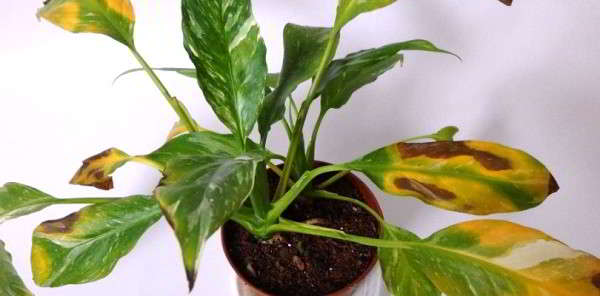

Is it harmful?
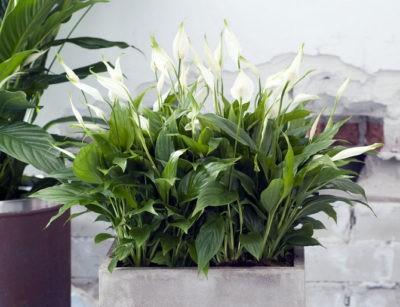

The flower is undeniably harmful to human health. Spathiphyllum is especially dangerous for children and people with reduced immunity.... If parts of an indoor flower were accidentally eaten, then this is fraught with the following consequences:
In addition, the upper respiratory tract becomes inflamed, and this leads to difficulty breathing. People who are prone to allergies can develop skin rashes and other allergic disorders.
What you need to do so that the leaves do not turn black
To make the leaves of the spathiphyllum look healthy, provide it with proper care:
- shade from direct sunlight;
- maintain the correct irrigation regime and high humidity;
- keep warm, avoid drafts;
- maintain a constant temperature background of 23-25⁰C, make sure that the temperature does not drop below 15⁰C;
- transplant "female happiness" into fresh soil every year, picking up a pot 1–2 cm wider than the previous one;
- do not overuse feeding, read the instructions for the purchased fertilizer;
- remove damaged, old leaves and wilting peduncles.
Do not forget to dust off the foliage or sprinkle.
Prophylaxis
You can avoid serious complications during the flowering period of a home plant if you take extreme care when caring for it. The essence of prevention is as follows:
- When pruning a plant, be sure to wear gloves on your hands. The fact is that during this procedure, the flower secretes juice that is poisonous to humans. If it comes into contact with the skin, it will turn red, there will be severe itching and a small rash.


After contact with leaves, wash your hands thoroughly with soap and water.- If the skin becomes reddened and discharged, rinse it with a strong stream of water and remove the remains of caustic juice.
- If the juice gets into the eyes, then rinse them thoroughly with water. When inflammation is significant, consult a doctor immediately.
- If part of the plant gets into your mouth, then rinse with milk or water. Moreover, do not swallow the liquid.
- During the flowering of the plant, take it to another room, and observe all precautions when caring for it.
How to provoke flowering?
Experienced flower growers know how to make spathiphyllum bloom. It is necessary to remove all unnecessary old parts, this will allow new inflorescences to develop.
Also, indoor plant lovers recommend to arrange shock therapy for spathiphyllum. This is done like this: take out a flowerpot with a plant in a room with cool air, not higher than 12 ° C, and leave it for 2 weeks. Then you need to bring it to the heat, nourish it with fertilizer. You can expect an early flowering.
In addition to poor care, all sorts of pests do not allow "women's happiness" to bloom. Most often, the following ones attack a flower:
In order for a flower to bloom, you need to treat it from pests. The preparations can be purchased at a specialized store and the plant should be processed according to the instructions.
In response to care and good care, it will decorate the room with its charming color, which will delight the owners of a tropical flower for a long time.
The conversation in this article will focus on beautiful flower spathiphyllum, which decorates the houses and apartments of many housewives. We will look at the causes of poor growth and flowering of spathiphyllum. We will tell you how to water, and so often the flower needs feeding. In this article, you will learn how to make spatiffilum bloom and more.
Spathiphyllum or spathiphyllum is a genus of perennial plants of the Aroid family that grow in the tropics (Central and South America). In the wild, Aroids grow in humid and swampy forests (near rivers and streams).
Deficiency of trace elements - the cause of yellowing of spathiphyllum
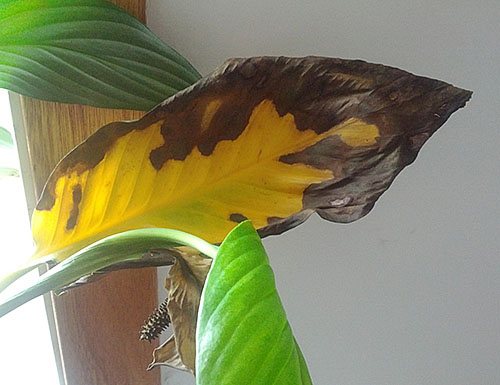

What to do if spatiffillum leaves turn yellow entirely? Most often, this symptom can be considered a sign of a lack of nutrition or a deficiency of certain elements in the soil. An ambulance in this case is feeding with complex fertilizer for indoor plants. If the roots of the flower are completely entwined with an earthen lump, then it is better to immediately transplant the plant, and, if necessary, divide a large bush.
Spathiphyllum is very sensitive to magnesium deficiency. Deficiency of this element leads to stunted growth and lethargy of the plant. In this case, the leaves of spathiphyllum turn yellow in such a way that the veins remain green, and the tissues between them become yellow or brown. Such bushes are fed with magnesium sulfate.
What are the consequences of the disease?
It is very important to identify the yellowing problem and save the plant as early as possible, because delay may cause it to wither.
Depending on what exactly caused the plant disease, it is calculated how much time there is to save the spathiphyllum. The problems listed above must be gradually and promptly eliminated one by one.
Flowers take on a greenish tint
Spathiphyllum flowers turn green for two reasons:
- Firstly, some varieties have this feature.
- Secondly, it is natural state of the flowerwhen the white blanket covering the ear changes color, it gives a sign that the flowering is coming to an end. If it turns green, you can cut off the peduncle, then energy will not be wasted, and soon it will begin to fill the buds again.
If, in parallel, the flower began to fade and turn black, then this is evidence that it has faded, and it is time to remove the peduncle. But when this happens to a plant that has just begun to bloom or unblown buds, then it is necessary to carefully examine it for the presence of parasites.
In their absence, the root system is carefully studied, if there is no change there, then the flower does not have enough nutrition for a full-fledged vegetation, complex fertilizers will help here.
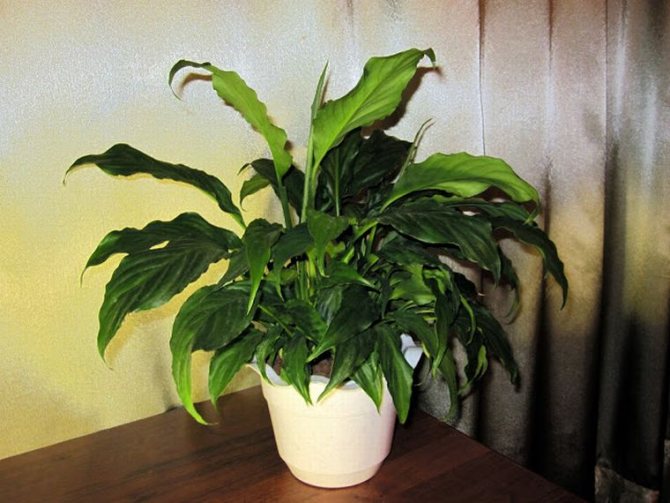

This plant is absolutely healthy
Late blight and its treatment
Among the diseases of spathiphyllum, late blight is also present, which manifests itself in the same way as rot from the base of the stems. Late blight forms on the root collar of a flower and over time is able to spread completely to the entire plant, slowly killing it. The causative agent of late blight is a fungus that is able to multiply quickly enough in a humid environment with the help of its spores. For this reason an infected plant with any force of defeat has to be destroyed (it is best to burn it to stop the growth of the fungus).
If among your indoor plants, at least one late blight has appeared, then all the rest will have to be treated with preparations that will increase the resistance of the plants. For this purpose, you can use "Ridomil Gold" or "Alet". In this case, pots with spathiphyllum will have to be held on land, trying to water them as rarely as possible.
As a preventive measure for spathiphyllums, you can also use the drugs Fitosporin-M, Alirin-B, Gamain-B and Planriz, the main thing is not to overdo it with their use.
Causes of the manifestation of diseases
Mainly, the reason for the manifestation of various diseases on the leaves lies in various care errors:
- dry indoor air, the plant (native of the tropics) lacks moisture;
- improper watering - may be insufficient or excessive;
- unsuitable room temperature, in summer you need warmth and insulation from drafts, and in winter you need coolness;
- the lighting was chosen incorrectly - either too bright for the plant, or, conversely, there is not enough light;
- dressings are applied in unsuitable doses - the plant may suffer from a lack of fertilizer or it may be overfed;
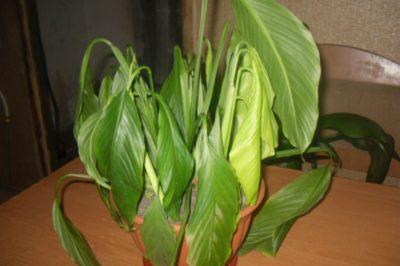

the soil is too dense and heavy, and this is unacceptable for Spathiphyllum;- the transplant is carried out out of time, too rarely.
- spider mites;
- aphids;
- scabbards;
- mealybugs.
Difficulties that may arise when growing
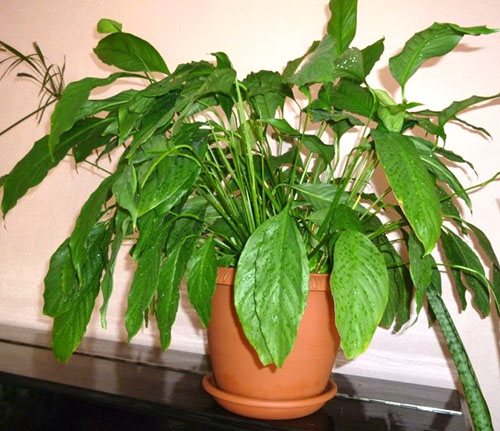

Let's take a closer look at the care and find the reasons why the handsome spathiphyllum does not bloom at home. Some of them may be:
- Improper lighting.
- Wet air.
- Watering the flower is incorrect.
- Insufficient or excessive feeding.
- Incorrect transplant.
Incorrect lighting
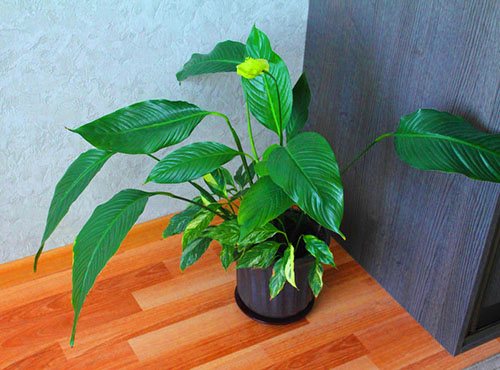

Spathiphyllium is a shade-loving plant. You should not put the pot in direct sunlight, as they are destructive for it, but the lack of light does not contribute to flowering. It is best to place the pot on the east side or on a table near the window. In bright light, the soil usually dries out quickly, and the leaves begin to turn yellow, the edges will take on a dark shade. With a lack of sunlight, the petals will change their shape to a more elongated one. At the same time, flowering may become less frequent or the plant will stop blooming altogether.
Wet air
Since the climate in the homeland of this flower is humid, it is worth spraying water around the plant and sprinkling the pebbles on which the pot stands. This is enough to have the necessary microclimate near it.
Watering the flower incorrectly
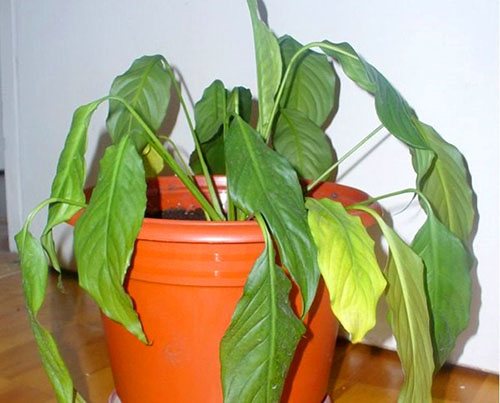

If spathiphyllum is improperly moisturized, then you should not wait for flowering, it can also provoke the death of the plant. Be sure to defend the water before watering, it should be at room temperature. In the warm season and during the flowering period, spathiphyllum must be well supplied with liquid. In winter, it is recommended to reduce watering, while the pot should not be placed near heating devices. If there is a lot of water, the leaves will drop, and if there is a lack of moisture, they will bend and become lethargic.
Water spathiphyllium as the soil dries.Spray it with room temperature water twice a week. Without regular irrigation, the leaves of the flower lose their elasticity. Wipe them with a damp sponge.
Try not to flood the plant! But if this happens, then let the water drain, and carry out the next watering only after the soil in the pot dries up. Large leaves evaporate a lot of moisture, so it is worth feeding such ornamental plants with water more often.
Insufficient or overfeeding
One of the reasons why spitiphyllum does not bloom at home may be insufficient nutrition. It is necessary to give additional substances for it during all periods of its development. In the spring and summer, feed at least once every 7 days. When it's cold outside, this food should be reduced to once a month. It is best to use special blends that can be purchased in stores. For spathiphyllum, fertilizers containing nitrogen and a small amount of potassium will be useful.
Do not overdo it, the presence of a large amount of substances can poison the flower.
Incorrect transplant
The flower grows quite quickly, and the roots quickly overwhelm the pot. Be sure to transplant it in a timely manner. Spathiphyllum multiplies by the so-called "babies". But at the same time he does not like forced separation. For readiness it is better to wait until the "baby" is fully ripe and becomes an independent plant. After that, it is advisable to transplant the formed bush into a separate pot.
Read also: Options for a canopy over the front door
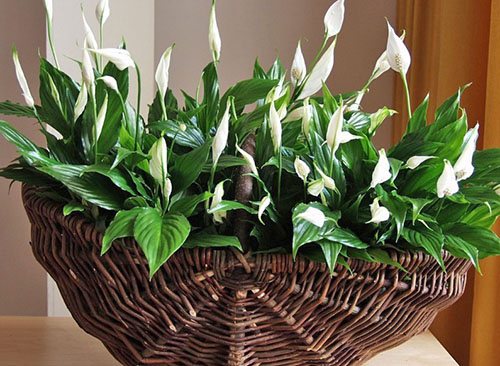

When planting or planting spathiphyllum, the soil must be chosen slightly acidic, this will contribute to the good development of the plant. It is worth dwelling on such a mixture: humus, leaf, peat, woody soil. The ratio should be 1: 1: 1: 2. Charcoal is also added for improvement. There must be good drainage. For loosening, it is good to add rotted wood or coniferous soil. If the substrate is dense, then the roots will be poorly supplied with air, and because of this, the plant will develop poorly.
Choose a pot for spatephyllum so that it is not large for the root. Flowering occurs only when the roots of the flower completely occupy the entire space in the pot.
Experienced housewives know the method of making spathiphyllum bloom. They argue that if you cut off the old unnecessary parts, then this is conducive to the early formation of new inflorescences.
If you follow the recommendations for caring for spatephyllum, then in return he will thank you with magnificent flowering.
The nuances of caring for spathiphyllum - video
Many housewives are worried: if spathiphyllum does not bloom on the windowsill, what to do in this case? This plant requires increased attention and proper care, only in this case it will delight the owners with beautiful snow-white flowers and lush shiny greenery. To find out why the plant does not bloom, you need to analyze step by step what was done wrong in the care.
Spathiphyllum pests: sooty mushroom
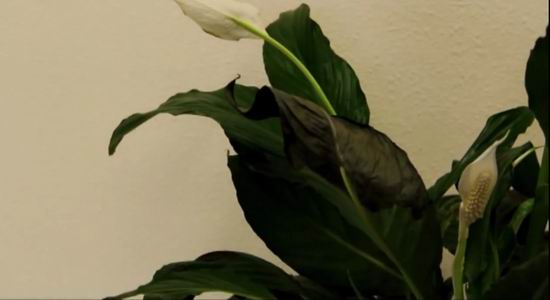

If spathiphyllum gradually began to acquire a black color, then this is a clear sign of late blight (sooty fungus). It spreads over the surface of all plant organs, being located on shoots and leaves, covering their upper part. In addition to pests that have already spread to the plant, which feed on plant tissues or suck juices from them, soot fungus disrupt the normal functioning of physiological processes. Over time, such a plant becomes lethargic.
A solution of soapy water will help to restore all processes, which will easily wash away this passive pest.
The considered representatives, not being the only pests of spathiphyllum, remain the most dangerous from the numerous list of household pests that exist today.
What if the plant weakens?
Due to overdrying
The flower will begin to wilt if it lacks moisture.... Watering in this case may not help, since an overdried clod of earth will quickly let water pass by itself, without having time to be nourished. The plant can be helped by immersing the flower pot in a container of warm water for 20 minutes. Water should not go over the top of the pot so that the soil does not pour out. During this time, the earth will be completely saturated. After that, you need to drain the water from the container and leave the pot in it so that the excess water is glass.
After that, it is advisable to spray the plant with a solution of the plant growth biostimulator Epin at a concentration of 6 drops per 100 ml of water.
Due to excess moisture
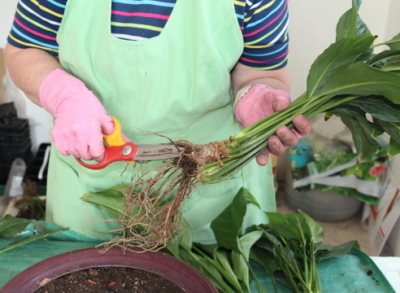

The plant will look depressed and from an excess of moisture... In this case, the roots are affected, root rot may begin. To save the plant, you need to pull it out of the ground, rinse the roots under running warm water and examine them.
Rotten roots are dark in color, they break off easily, you need to remove them. The remaining light roots can be treated with a solution of Zircon, a strong immunomodulator that stimulates the formation and growth of the root system. It is diluted with 4 drops per liter of warm water and treated with the roots (subsequently, the earth is watered with such a solution).
Due to an incorrectly selected pot
Young spathiphyllum begins to grow when its roots grow enough to fill the entire space in the pot. therefore a young plant is immediately planted in a small pot... As the plant grows, the pot is gradually increased.
If a too large pot is immediately chosen for spathiphyllum, its young roots cannot cope with an excess of moisture, the ground turns out to be constantly wet. Root decay occurs and the flower withers. If you do not transplant it into a smaller pot in time, the plant will die.
How to save spathiphyllum in case of illness?
- The bacteria that cause flower disease can infect the root system. This occurs with prolonged overflow, followed by the formation of root rot. The plant urgently needs to be removed from the ground, rinsed the roots, remove the rotten ones, and keep the remaining healthy ones in a root growth stimulator. Suitable for this: Zircon (4 drops per 1 liter of water), Kornevin or Heteroauxin.
Why is this happening?
Because of what there may be drooping leaves in spathiphyllum:
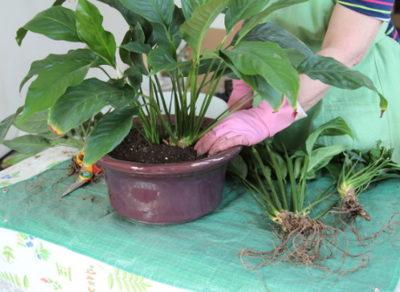

Post-transplant stress. You cannot water abundantly and fertilize the plant until it gets used to the new conditions.- Overdrying. The flower grower did not properly organize the watering of the flower.
- Abrupt changes in conditions of detention. In winter, they do not open the window wide open, and in summer they do not leave it without darkening on the balcony under the hot rays of the sun.
- Overflowing. Due to the abundance of moisture, the water balance between leaves and roots is disturbed, and the soil water stops evaporating.
- Oversupply of fertilizers.
- Pests hiding under the leaf plate are noticed too late, when the spathiphyllum can no longer be saved.
Plant characteristics
This plant has an unusual appearance. Spathiphyllum does not have a stem, the leaves grow directly from the soil in a small bush. The petiole is elongated. Whole leaves can be oval or lanceolate. The veins are thin, the central ones are more clearly distinguished, and the lateral ones are thinner. The root system is well developed, but the roots themselves are small. Pedicel length as petiole or slightly more.
The inflorescence is an ear with a veil extending from the base (popularly called a "sail"). The coverlet, like the leaves, is elliptical-oblong, it exceeds the length of the cob and looks like a leaf, only it stands out in color. The color can be from white to green. But, even if the color is green, it differs by 2-3 tones from the color of the leaves.
After the plant has bloomed, the veil turns green. The ear is sessile or pedunculated. The flowers are bisexual, the seeds are smooth, slightly curved.
“Female happiness” is the second name for a flower, but few people know that, in contrast to it, Anthurium is called “male happiness”.
The plant is native to the tropical regions of South America. Spathiphyllum has a wide distribution area. In the wild, it is found throughout America, in the Philippines, Sulawesi, New Guinea, New Britain, the Solomon and Moluccas, and Palau. Grows in humid areas (swampy forests, near lakes, rivers). As a rule, these are terrestrial crops, but there are chemiepiphytes and epiphytes.
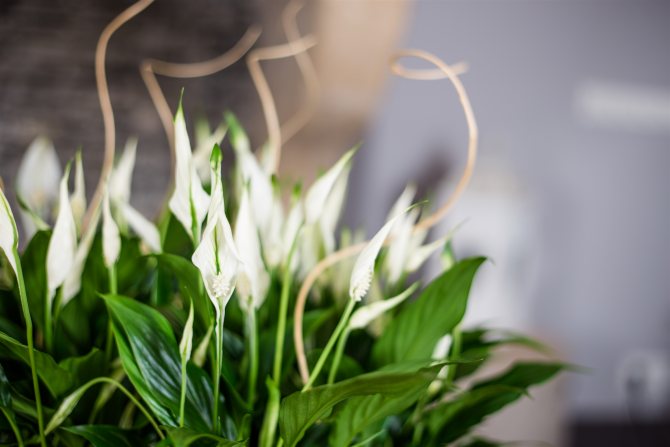

What is wilting?
By itself, wilting means the loss of freshness, drying out.
Definition
Withering of plants is a disease in which leaves, branches, buds, flowers wither... The plant loses turgor (elasticity) of the leaves, they look lifeless.
Spathiphyllum appearance
An unhealthy plant has a depressed look on the leaves. Usually, the leaves, which are proudly standing up, wither when withering, "hugging" a flower pot. The color of the leaves loses its bright color, losing its gloss.
What parts of the shoot can wilt?
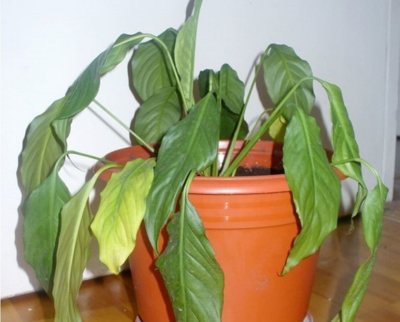

The first thing that attracts attention is the leaves.... In addition to the drooping appearance, the tips of the leaves dry and turn black, spots appear on the leaf blades. All these signs are due to different reasons. If the cause is not established in time, the disease progresses further (for details on how to treat spathiphyllum for leaf diseases, read here).
After the gradual fall of the leaves, the trunk also begins to wither. Since the trunk (rhizome) does not have an aerial part and is located in the ground, the disease quickly spreads to the roots. If this process is not stopped in time, the flower will die.
On the rhizome, which is located under a layer of earth, buds grow. Daughter sockets gradually grow out of them. If the leaves have already fallen off, you need to try to save healthy buds. The flower, or rather what is left of it, must be pulled out of the ground and examined the roots. In the event that the roots are light and not rotten, it is necessary to carefully clean the rhizome from rot, removing the dry stems of the leaves, and leave healthy buds. They will soon grow.
Why doesn't it bloom
The reasons why spathiphyllum only releases leaves can be different. Therefore, it is necessary to understand in detail the care, based on this, it will be possible to find the reasons because of which "female happiness" has ceased to please the owners with its beautiful color. Possible culprits for plant diseases are listed below:
- Inappropriate lighting.
- Air humidity around the flower.
- Poor watering of spathiphyllum.
- Poor or, conversely, excessive fertilization.
- Incorrect plant transplant.
Further, each item will be described in detail, from which it will be possible to draw conclusions about why the flower does not bloom.
How to destroy scale insects on leaves
The scabbard on spathiphyllum does not appear often, but it manifests itself quite intensively and multiplies very quickly. While the scale insect is still young, it is even difficult to notice it on the plant. Only dark spots, which will rapidly begin to appear both on the leaves of the spathiphyllum and on its stems, will be able to tell about its presence.
A folk remedy, which is a solution of soap and tobacco, will help get rid of the scale insect. To enhance the effect in the fight against the scabbard, you can add a little kerosene to this spray solution. If the scale insects have reached adulthood, and they can be viewed with the naked eye, then you can even remove them from the plant with damp tampons, after which you will still need to spray with soapy water.
Important! A spathiphyllum transplant must be carried out every spring. If the plant has grown a lot, be sure to increase the diameter of the pot. It is also necessary to lay a drainage layer at the bottom of the pot, which will provide the plant with protection from rot.
What does spathiphyllum look like
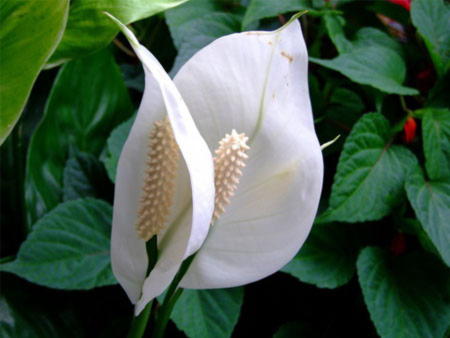

The foliage is basal, oval in shape with solid edges. In the center of the leaf, the main vein and the thinner veins adjacent to it are clearly distinguished. The petioles expand at the base.
The inflorescence of the plant, as a rule, is represented by a white blanket, which is located around the cob. However, there are varieties of spathiphyllum with a greenish veil. The flowering period lasts from two to three weeks in spring. With proper care, the plant can bloom again in the second half of summer or early fall. At the end of the flowering period, dry inflorescences must be cut off.
Species able to live in rooms
There are about fifty species in the genus, sometimes very different from each other. Among them there are very tiny plants, and there are real herbaceous giants, there are lovers of swamps, but there are even epiphytes - living on trees. In all this diversity, only representatives of five species submitted to botanists, adapting to life in apartments. On the basis of this five, many varieties and hybrids have been created.
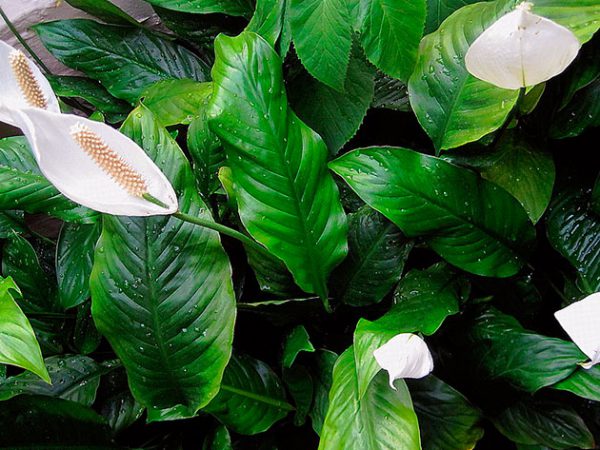

Spathiphyllum profusely flowering (Spathiphyllum floribundun). It stands out for its long, rich flowering. The average height is about half a meter, the leaves are 15-20 cm, the width is 8 to 12 cm. The peduncle is much longer than the bedspread. Among the representatives of the species there is a clear leader, the most popular hybrid "Mauna loa"With large leaves and prone to multiple flowering. This variety, due to its size, is difficult to fit on a regular windowsill.
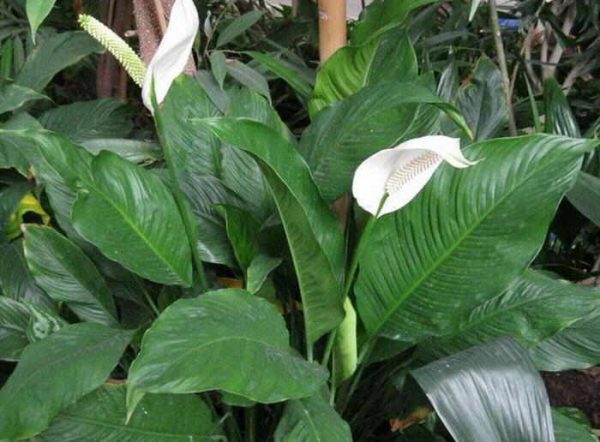

Wallis Spathiphyllum (Spathiphyllum wallisii). An unpretentious, shade-tolerant plant, no more than 40 cm high. In contrast to the abundant flowering, this species has a veil noticeably longer than the peduncle. Flowering lasts longer than other spathiphyllums.
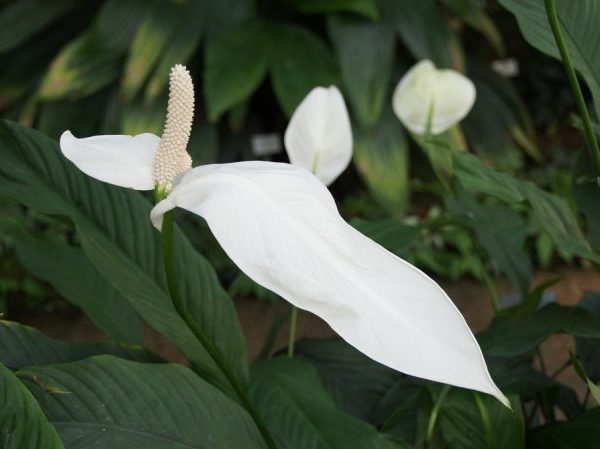

Spathiphyllum adorable (Spathiphyllum blandum). A large plant with many inflorescences. The bedspread initially had a greenish tint, resembles a flag, which is why the plant is also called a flagleaf.
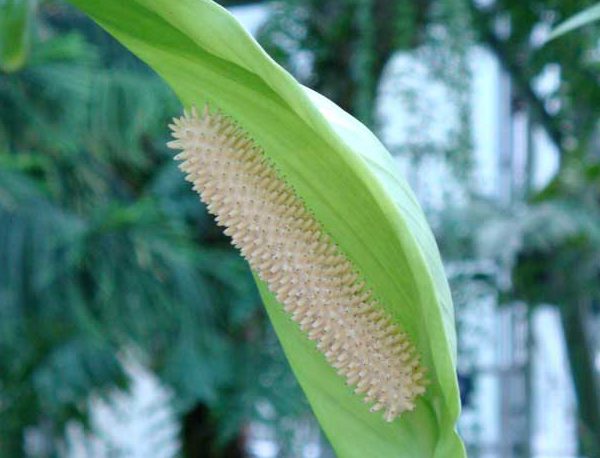

Spathiphyllum spoon-shaped (Spathiphyllum cochlearispathum). One of the largest types, also not for window sills. Its size is explained not only by the length of the leaves (about 40 cm), but also by thick, long petioles. The width of the leaf can be 20 cm, and its edges have a wavy shape.
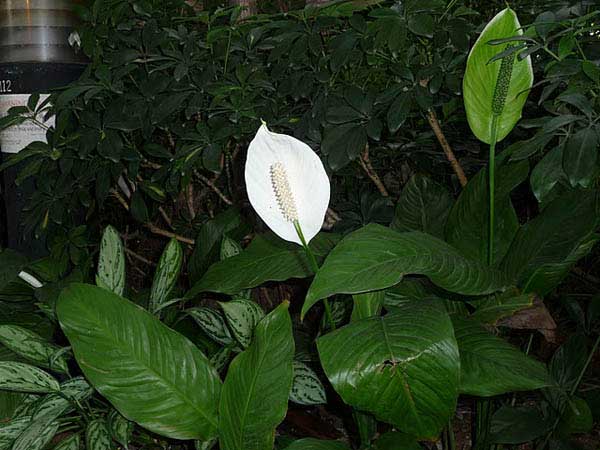

Spathiphyllum cannoli (Spathiphyllum cannifolium). The bedspread is also greenish, and the inflorescence has a yellowish tint. Leaves are ovoid, resembling canna leaves.
Many varieties and hybrids have been created on the basis of these species. For example, the variety "Mini"Is only 10 cm high, and the variety"Sensation"Reaches one and a half meters, and can bloom continuously for several months!
Transfer
Immediately after acquiring female happiness, you need to pay attention to the pot and the ground in which it grows. If the purchase was carried out in a store and the pot is technical, then after 2-3 weeks it needs to be transplanted. The pot is taken larger, and the earth is new.
Home care for spathiphyllum is carried out daily, but the transplant is annually. It is better to select a pot by size or slightly larger, especially if the plant is developing rapidly. The material of the pot does not play any role. The only thing worth considering is that a container with thin plastic is inconvenient in everyday life. It quickly deteriorates (breaks, cracks, smears out). If the flower is grown for yourself, and not for sale, it is better to give preference to ceramics, hard plastic or glass.
Not every land is suitable for female happiness. It is advisable to do it yourself, if possible. For 2 parts of sod, 1 part of peat, leafy earth, sand and humus is taken. You can also add charcoal, brick chips for drainage. So that the earth does not dry out, sphagnum moss is laid on top. If it is not possible to make the land yourself, you can buy a ready-made one in a flower shop.
When the new pot and soil are ready, the flower is removed from the old container, slightly cleaned of the old soil, but carefully so as not to damage the roots. After that, a slide of earth is made in a new pot, a flower is set on it, and the roots are straightened on all sides. You cannot deepen the flower! In order for the soil to be compacted a little, watering is carried out, and the required amount of earth is poured on top.
Watering after transplanting is stopped for about 3 days, but it is very important to spray instead of them so that the spathiphyllum does not dry out.
Mealybug: how to prevent a plant from getting sick
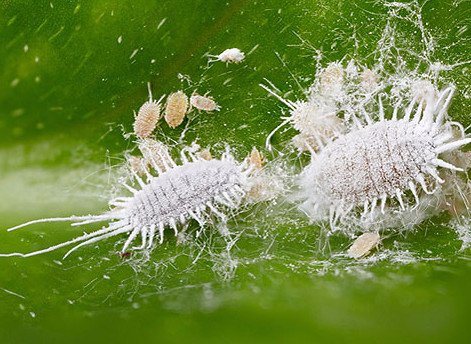

Among all diseases and pests of spathiphyllum, the most insidious is the mealybug.It affects the plant very rarely, but this often happens due to the excessive satiety of the flower. If you overfeed the spathiphyllum, worms can grow between its leaves, which, over time, can completely destroy the flower.
With a large accumulation of worms, they are simply removed with a cloth soaked in alcohol. You can also use citrus peel tincture against them. The most effective remedy against this pest is insecticidal preparations, the concentration of which can be significantly increased until the mealybugs disappear completely. The plant will also need to be treated with actellic.
Are there varieties with green flowers
Not everyone knows, but spathiphyllum (or in the popular way - spatik) has many varieties. For example, in stores we are offered a pleasant (also known as adorable), profusely blooming spathiphyllum, varieties Sensation, Chopin. All of these plants have white veils.
True, there is also Alan's female happiness with slightly greenish tips of the veils:
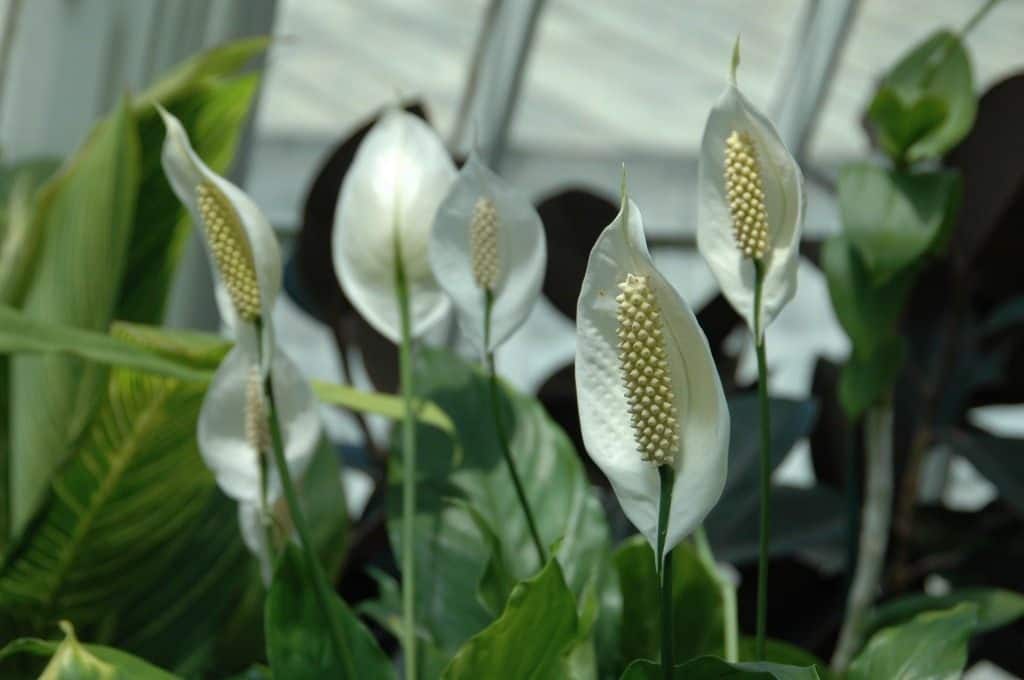

There is also a Heliconium spatium, the white flowers of which turn green as they age.
Finally, I can't help but remember Picasso. This is probably the most original spatic. Even if it does not bloom, the bush still looks very elegant and bright. True, where to buy one, I do not know yet - I know him exclusively on the Internet, and I have not yet met such female happiness in ordinary stores.
Greening flowers is a sign of illness or natural development
Why does the spathiphyllum flower turn green - the reasons for this condition may be completely natural and not harmful to it. For clarification purposes, it should be noted once again that it is only the bracts that change color, and not the peduncle itself. One of the normal reasons is that the plant gradually gets old: the older it is, the less chance it naturally has of pollination. The bract, as unnecessary, begins to lose color and turns green, merging with the foliage. In this case, it is recommended to carry out a light anti-aging pruning for your favorite flower. Old inflorescences are carefully cut off with a sharp object, give the opportunity to emerge faster with a new one.
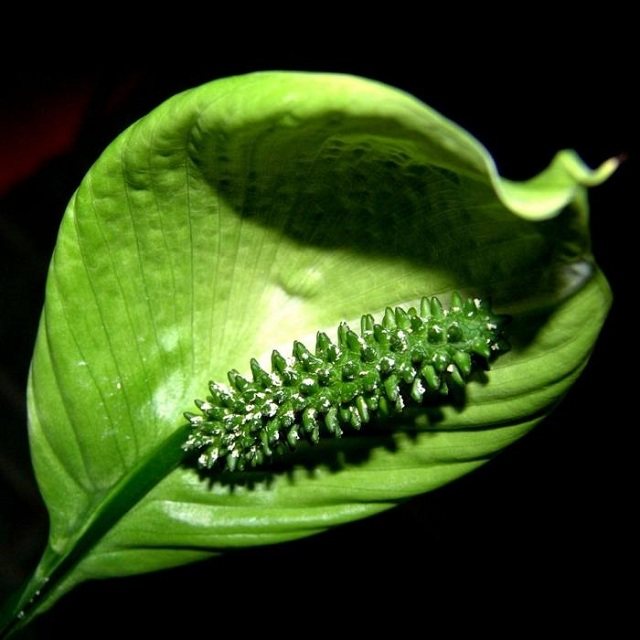

Another quite natural reason for the color change of the bedspread is the long stay of the flower in a too hot place with direct sunlight. Spathiphyllum, despite its tropical origin, does not like such light, and can react to it not only by fading and greening of the bracts, but also by foliage burns and wilting. It is necessary to move the plant to a cooler place with diffused and soft light, while not allowing the flower to stay in completely shaded areas of the room.
Rules for rendering assistance if roots rot
To restore the previous state of the roots, you cannot do without transplanting.
- Remove the plant from the pot, analyze the root system.
- Rinse the roots under warm running water.
- With a sharp disinfected instrument, remove rotten, inanimate roots, no matter how many, to living tissue.
- Disinfect the sections with ash or sulfur powder.
- Let them dry.
- If necessary or for the purpose of prophylaxis, treat with a weak fungicide solution.
- Transplant the flower into a new dry soil, loose, light, mineralized, of the correct composition.
- A drainage layer and medium-sized holes in the bottom of the pot are required.
- There is no need to water immediately after transplanting.
- In the future, apply root formation stimulants.
Transplanting a plant with errors
"Women's happiness" is rapidly growing and developing, and the root system is no exception, which completely fills the pot in a short time. "Women's happiness" needs to be transplanted on time, the appropriate period is in the spring. The flower pot is chosen a little more than the previous one.
It is propagated by children. However, the plant does not like forced separation.In order not to harm the entire spathiphyllum, it is better to wait for the full development and formation of the baby into an adult plant. After ripening, the finished plant is transplanted into a suitable pot.
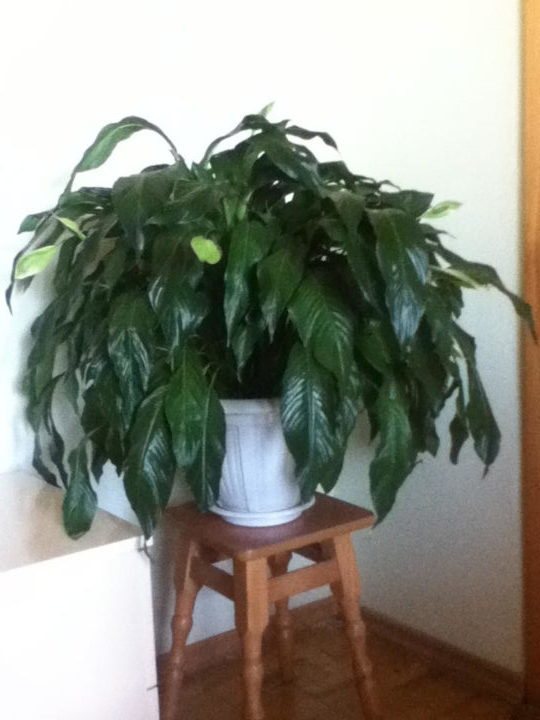

Pot size required
When a specimen is transplanted into a new pot or children are planted, then the soil is chosen slightly acidic, this will have a beneficial effect on the growth and development of the individual. It is recommended to opt for such a mixture: manure and leaf, peat, woody soil in a ratio of 1: 1: 1: 2. Charcoal is also added. A high-quality drainage system is required. To make the soil looser, it is advisable to add rotten wood or coniferous soil. In the case of a dense substrate, there will be poor air circulation, this will cause slow development and lack of flowering.
The flowerpot must be selected for "female happiness" is not too large, the roots should not dangle there. Spathiphyllum blooms only after the roots fill the container.
Pests and diseases
According to the state of spathiphyllum, it is usually easy to understand that something is missing or there are other problems.
Of the pests, Spathiphyllum is most often annoyed:
- thrips
- spider mite
- mealybug
They fight them by spraying with special preparations that can be purchased at any flower shop. For example: "ExtraFlor", "Fitoverm", "Actellik", "Bona Forte", "Iskra gold"
Causes of illness and unhealthy appearance and ways to solve them:
- The leaves are drooping - the plant has little moisture.
- Brown specks on the leaves - indicate too much nutrients in the ground. In this case, you must either transplant the plant, or stop feeding for 2-3 weeks.
- Lack of flowering for a long time indicates a lack of nutrients in the earth. A simple top dressing with universal fertilizer for indoor flowers will help to correct the situation.
- Dry tips of the leaves of Spathiphyllum - there are too many irrigations or, on the contrary, not enough, the edges of the leaves begin to turn yellow and dry.
- Blackened and dried leaves are a sign of a lack of phosphorus and nitrogen. To solve the problem, you need to purchase a good flower fertilizer (there should be a lot of nitrogen and phosphorus in the composition), and top dressing every 1 week (2-3 times).
Female happiness can grow in any room, even with minimal lighting, but if you keep it in the shade all the time, the leaves will begin to shrink. So if the new leaves grow small, then you just need to move the plant to a brighter place.
Spathiphyllum is rarely susceptible to disease. His illnesses in most cases are the result of improper care. If you notice and identify the cause of this condition in time, you will be able to save it. The main thing is to look after him correctly afterwards.

